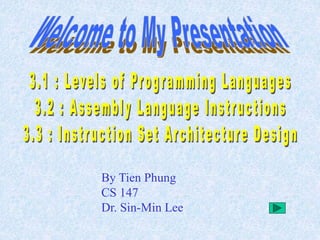
5059734.ppt
- 1. By Tien Phung CS 147 Dr. Sin-Min Lee
- 2. • High-level Languages • Assembly Languages • Machine Languages
- 3. • Highest level of abstraction • Platform-independent: same program code can be converted and run on computer with different microprocessors and operating system without modification. • C ++, Java, Fortran
- 4. • Lower level of abstraction. • Not platform-independent. • Backward compatible. • Can directly manipulate the data stored in a microprocessor’s interval components.
- 5. •Contain binary values •Instruction is read and executed directly by microprocessor. •Platform-specific: each microprocessor has its own machine language.
- 7. Compilation process for HLL High-level language program (C++, Fortran, etc.) Compiler for Pentium Windows PC Compiler for G4 Power Mac Computer Compiler for SPARC UNIX workstation Other Pentium object files Pentium object code Other G4 object files G4 object code Other SPARC object files SPARC object code Pentium linker G4 linker SPARC linker Pentium executable file Windows Pentium PC G4 executable file G4 Power Mac SPARC Executable file SPARC UNIX workstation
- 8. Process for assembly language programs. Assembly Language Program for processor X Assembler for processor X Processor X object code Process X linker Processor X executable file Computer with processor X Other processor X object file
- 9. • Data Transfer Instructions • Data Operation Instructions • Program Control Instructions
- 10. • Do not modify data, only copy value to its destination. • Main operation: move data from one place to another * Load data from memory into microprocessor. * Store data from microprocessor into memory. * Move data within the microprocessor. * Input data to the microprocessor. * Output data from the microprocessor.
- 11. • Modify their data value • Arithmetic instructions: add, subtract, multiply and divide. • Logic instruction: AND, OR, XOR, or complement a single value. • Shift instruction: shift the bits of data value to either left or right.
- 12. • Use jump or branch to go to another part of the program. (jr $ra) • Conditional calls and returns bne $t0, $t1, endloop • Software and hardware interrupts • Exception or traps • Half-instruction: stop executing instruction
- 13. • Integer < Unsigned 0 to 2n - 1 Signed -2 n-1 to 2 n-1 - 1 • Floating Point • Boolean < True = non-zero False = zero • Characters: * Stored as binary values * Encoded using ASCII, EBCDIC, UNICODE.
- 14. • Direct Mode • Indirect Mode • Immediate Mode • Implicit Mode
- 15. a) Direct Mode 0: LDAC 5 instruction gets data from location 5 5: 10 stores value in CPU b) Indirect Mode 0: LADC @ 5 instruction gets address from location 5 5: 10 then gets data from location 10 10: 20 stores value in CPU
- 16. c) Immediate Mode 0: LDAC #5 stores value from instruction in CPU d) Implicit Mode 0: LDAC instruction gets value from stack stack store value in CPU
- 17. • Instruction code: assembly language instruction converted to machine code as binary value (0 and 1) • Opcode needs 4 bits • Operand needs 2 bits • A microprocessor may be designed to work with instructions that specify 3, 2, 1 or 0 operands.
- 18. 2 bits 2 bits 2 bits 4 bits 2 bits 2 bits 4 bits 2 bits 4 bits 4 bits opcode operand #1 opcode opcode opcode operand #2 operand #3 operand #1 operand #2 operand ADD A,B,C (A=B+C) 1010 00 01 10 MOVE A,B (A=B) 1000 00 01 ADD A,C (A=A+C) 1010 00 10 LOAD B (Acc=B) 0000 01 ADD C (Acc=Acc+C) 1010 10 STORE A (A=Acc) 0001 00 PUSH B (Stack=B) 0101 PUSH C (Stack=C,B) 0110 ADD (Stack=B+C) 1010 POP A (A=Stack) 1100
- 19. • Need more instructions to accomplish the same task. • Hardware implement the microprocessor become less complex as the number of operand decreases. • Instructions code use fewer bits. • Microprocessor execute instruction more quickly.
- 20. • Completeness: Does the instructions set have all of the instruction a program needs to perform its required task? • Orthogonality: No overlap or perform the same function. • Good Instruction < Minimize overlap between instructions Provide programmers necessary functions with less instructions.
- 21. • Large effect on performance of CPU • CPU retrieve data from its registers more quickly than from memory. • Speed up program execution.
- 22. Concerning Question About ISA Design • Does this processor have to be backward compatible with other microprocessor? • What types and size of data will the microprocessor deal with? • Are interrupts needed? • Are conditional instruction needed? Flag: zero, carry, sign